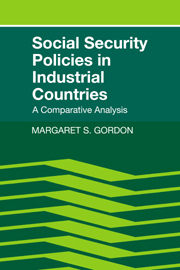Book contents
- Frontmatter
- Contents
- Preface
- Acknowledgments
- Abbreviations
- 1 Postwar developments
- 2 Differences in social security spending
- 3 National old-age pension programs: basic structure
- 4 Other major features of old-age pension programs
- 5 The age of retirement
- 6 Long-term invalidity programs
- 7 Industrial injuries programs
- 8 The role of employer pension plans
- 9 The economic impacts of pension programs
- 10 Health benefits
- 11 Unemployment compensation
- 12 Labor market policies
- 13 Family allowances and family policies
- 14 Public assistance and guaranteed income proposals
- 15 International linkages
- 16 Conclusions
- Appendix 1
- Appendix 2
- References
- Index
5 - The age of retirement
Published online by Cambridge University Press: 06 July 2010
- Frontmatter
- Contents
- Preface
- Acknowledgments
- Abbreviations
- 1 Postwar developments
- 2 Differences in social security spending
- 3 National old-age pension programs: basic structure
- 4 Other major features of old-age pension programs
- 5 The age of retirement
- 6 Long-term invalidity programs
- 7 Industrial injuries programs
- 8 The role of employer pension plans
- 9 The economic impacts of pension programs
- 10 Health benefits
- 11 Unemployment compensation
- 12 Labor market policies
- 13 Family allowances and family policies
- 14 Public assistance and guaranteed income proposals
- 15 International linkages
- 16 Conclusions
- Appendix 1
- Appendix 2
- References
- Index
Summary
One of the most important dilemmas in relation to income security for the aged stems from the conflict between demographic trends, which suggest the desirability of gradually raising the conventional age of retirement, and economic forces, which tend to exert pressure toward earlier retirement. There has been a pronounced trend toward earlier retirement of elderly men in industrial countries throughout the period since the latter part of the nineteenth century, whereas in the case of women the proportion in the labor force at advanced ages has been small during the entire period.
Since the 1960s, the trend toward earlier retirement of men has continued in industrial countries, whereas the labor force participation rates of elderly women have not changed greatly, at least for those aged 65 or more. Moreover, numerous measures have been adopted to facilitate early retirement, and, at the same time, the concept of a more flexible retirement age in both directions has been encouraged through the provision not only of early retirement measures but also of incentives for postponing retirement under national social security policies.
Although the long-term trend toward increased life expectancy has chiefly reflected the increase in life expectancy at birth, there has been some tendency in the past few decades for life expectancy at age 65 to increase at a more pronounced rate than life expectancy at birth, at least in some of the industrial countries.
- Type
- Chapter
- Information
- Social Security Policies in Industrial CountriesA Comparative Analysis, pp. 85 - 110Publisher: Cambridge University PressPrint publication year: 1989



